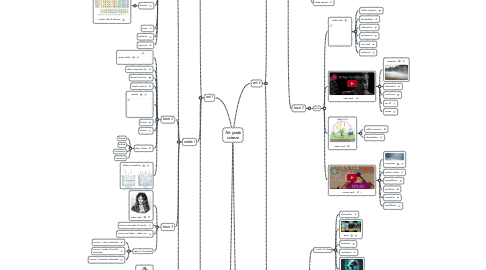
1. unit 1
1.1. Module 0
1.1.1. section 1
1.1.1.1. the scientific method
1.1.1.1.1. observations
1.1.1.1.2. questions
1.1.1.1.3. hypothesis
1.1.1.1.4. prediction
1.1.1.1.5. test the predition
1.1.1.1.6. Quantitative observations
1.1.1.1.7. Qualitative observations
1.1.1.1.8. Publish / Peer Review
1.1.1.1.9. Iterative process
1.1.2. section 2
1.1.2.1. claim
1.1.2.2. evidence
1.1.2.3. reasoning
1.1.3. section 4
1.1.3.1. DRY
1.1.3.2. MIX
1.1.3.3. LENSES
1.1.3.3.1. Label and list
1.1.3.3.2. Equation
1.1.3.3.3. Notice
1.1.3.3.4. Speculate
1.1.3.3.5. Explain/Evaluate
1.1.3.3.6. summary
1.1.4. section 5
1.1.4.1. Lab safety standards
1.1.4.1.1. Hair in a lab
1.1.4.1.2. Clothing in a lab
1.1.4.1.3. Footwear in a lab
1.1.4.1.4. protective glasses
1.1.4.1.5. colors of health hazard symbols
1.1.4.1.6. MSDS
1.1.4.1.7. pipetting
1.2. module 1
1.2.1. lesson 1
1.2.1.1. atoms
1.2.1.1.1. matter
1.2.1.2. energy
1.2.1.2.1. kinetic energy
1.2.1.2.2. potential energy
1.2.1.2.3. thermal energy
1.2.1.3. temperature
1.2.1.3.1. kelvin scale
1.2.1.3.2. thermometer
1.2.1.4. elements
1.2.1.4.1. Periodic Table of Elements
1.2.1.5. atoms
1.2.1.6. substances
1.2.1.7. compounds
1.2.2. lesson 2
1.2.2.1. Jacques charles
1.2.2.2. volume temperature law
1.2.2.3. thermal contraction
1.2.2.4. thermal expansion
1.2.2.5. systems
1.2.2.6. heating
1.2.2.7. pressure
1.2.2.8. phase change
1.2.2.8.1. freezing
1.2.2.8.2. melting
1.2.2.8.3. condensation
1.2.2.8.4. vaporization
1.2.2.9. boiling vs evaporation
1.2.3. lesson 3
1.2.3.1. Robert Boyle
1.2.3.2. pressure and number of particles
1.2.3.3. Pressure and Volume - Boyles Law
1.2.3.4. Types of relationships
1.2.3.4.1. Pressure / Volume relationship
1.2.3.4.2. Pressure / Number of particles relationship
1.2.3.4.3. Pressure / Temperature relationship
1.2.4. lesson 4
1.2.4.1. metals
1.2.4.2. nonmetals
1.2.4.2.1. nonmetal gas
1.2.4.2.2. nonmetal solid
1.2.4.3. molecules
1.2.4.4. Ionic compounds
1.2.4.5. covalent compounds
1.2.4.5.1. polar covalent compounds
1.2.4.5.2. nonpolar covalent compounds
1.2.4.6. Dissolving
1.3. module 2
1.3.1. lesson 1
1.3.1.1. Chemical Properties
1.3.1.1.1. Flammability
1.3.1.1.2. Oxidation
1.3.1.1.3. Reactivity
1.3.1.1.4. Solubility
1.3.1.2. physical properties
1.3.1.2.1. qualitative characteristics
1.3.1.2.2. quanitative characteristics
1.3.1.3. mass
1.3.1.4. volume
1.3.1.5. weight
1.3.1.6. density
1.3.2. lesson 2
1.3.2.1. chemical change
1.3.2.2. chemical reaction
1.3.2.2.1. reactants
1.3.2.2.2. products
1.3.2.3. chemical equations
1.3.2.4. Antoine Lavoisier
1.3.2.5. Coefficients
1.3.2.6. Atomic Mass
1.3.2.7. the law of conservation of mass
1.3.3. lesson 3
1.3.3.1. Chemical Potential Energy
1.3.3.2. Endothermic Reactions
1.3.3.3. Exothermic Reaction
1.3.3.4. Concentrations in reactions
1.3.3.5. Law of conservation of energy
2. unit 2
2.1. Module 1
2.1.1. Lesson 1
2.1.1.1. Pangea
2.1.1.2. Continental Drift
2.1.1.3. Rock formation evidence
2.1.1.4. Glacial features evidence
2.1.1.5. Coal Deposit Evidence
2.1.1.6. Fossil Evidence
2.1.1.7. Alfred Wegener
2.1.2. lesson 2
2.1.2.1. ocean floor topography
2.1.2.2. mid ocean ridges
2.1.2.3. Ocean Trenches
2.1.2.4. isochron maps
2.1.2.5. seafloor spreading
2.1.2.6. magma
2.1.2.7. lava
2.1.2.8. plate tectonics
2.1.3. lesson 3
2.1.3.1. Fold Mountains
2.1.3.2. Convergent Boundary
2.1.3.3. Divergent Boundary
2.1.3.4. Transform Boundaries
2.1.3.5. Subduction
2.1.3.6. Fault
2.1.3.7. Fault Block Mountains
2.1.3.8. Volcano
2.1.3.9. Volcanic Arc
2.1.3.10. Earthquake
2.1.3.11. Fault Zone
2.1.3.12. Landslide
2.1.3.13. Tsunami
2.1.3.14. Impact Craters
2.1.4. lesson 4
2.1.4.1. Physical Weathering
2.1.4.1.1. Frost Wedging
2.1.4.1.2. Plant Action
2.1.4.2. Abrasion
2.1.4.2.1. Wind Abrasion
2.1.4.2.2. Water Abrasion
2.1.4.2.3. Glacial Abrasion
2.1.4.3. Chemical Weathering
2.1.4.3.1. Oxidation
2.1.4.3.2. Hydrolysis
2.1.4.3.3. Carbonation
2.1.4.4. Erosion
2.1.4.4.1. Small Scale Erosion
2.1.4.4.2. Large Scale Erosion
2.1.4.5. Deposition
2.1.5. lesson 5
2.1.5.1. Rock
2.1.5.2. Mineral
2.1.5.3. Crystallization
2.1.5.4. Igneous Rock
2.1.5.4.1. Extrusive
2.1.5.4.2. Intrusive
2.1.5.5. Sedimentary Rock
2.1.5.5.1. Lithification
2.1.5.5.2. Compaction
2.1.5.5.3. Cementation
2.1.5.6. Metamorphic Rocks
2.1.5.7. The Rock Cycle
2.2. module 2
2.2.1. lesson 1
2.2.1.1. Earthquakes and Plate Boundaries
2.2.1.2. Richter Magnitude Scale
2.2.1.3. Earthquake Magnitude
2.2.1.4. Moment Magnitude Scale
2.2.1.5. Modified Mercalli Intensity Scale
2.2.1.6. Structural Failure
2.2.1.6.1. Pancaking
2.2.1.6.2. Building Height
2.2.1.7. Liquefaction
2.2.1.8. Landslide
2.2.1.9. Tsunami
2.2.2. lesson 2
2.2.2.1. Volcano Belts
2.2.2.2. Hot Spots
2.2.2.3. Volcanic Hazard
2.2.2.3.1. Mudflows
2.2.2.3.2. Lava Flows
2.2.2.3.3. Volcanic Ash
2.2.2.3.4. Volcanic Gases
2.2.2.3.5. Landslides
2.2.2.3.6. Pyroclastic Flows
2.2.2.4. Predicting Volcanoes
2.2.2.4.1. Gas
2.2.2.4.2. Deformation
2.2.2.4.3. Ground Vibration
2.2.2.4.4. Remote Sensing
2.2.2.4.5. Lava Collection
2.2.3. lesson 3
2.2.3.1. Hurricane
2.2.3.2. Saffir-Simpson Hurricane scale
2.2.3.3. Tornado
2.2.3.4. Enhanced Fujita Damage Intensity Scale
2.2.3.5. Flood
2.2.3.6. Drought
2.2.3.7. Drought Hazards
2.2.3.7.1. Soil Erosion
2.2.3.7.2. Wildfires
2.2.3.7.3. Decrease in water supply
2.2.3.7.4. Agricultural Impact
2.2.3.8. Predicting severe weather
3. unit 4
3.1. module 1
3.1.1. lesson 1
3.1.1.1. photosynthesis
3.1.1.1.1. Photosynthesis - Light Cycle
3.1.1.1.2. Photosynthesis - Night Cycle
3.1.1.2. Epidermal Leaf Cells
3.1.1.3. Cuticle
3.1.1.4. Stomata
3.1.1.5. Mesophyll Cells
3.1.1.6. Chloroplasts
3.1.1.7. Chlorophyll A and B
3.1.1.8. Different Sugars for different plants
3.1.1.9. Cellular Respiration
3.1.1.10. Glycolysis
3.1.1.11. Mitochondria
3.1.1.12. Fermentation
3.1.1.12.1. Animal Fermentation - Lactic Acid
3.1.1.12.2. Plant Fermentation - Ethanol alcohol
3.1.1.13. Photosynthesis / Cellular Respiration Connection
3.1.2. lesson 2
3.1.2.1. Producers
3.1.2.2. Consumers
3.1.2.2.1. Primary Consumer
3.1.2.2.2. Secondary Consumer
3.1.2.2.3. Tertiary Consumer
3.1.2.3. Detritivores
3.1.2.4. Food Chain
3.1.2.5. Food Web
3.1.2.6. Energy Pyramid
3.1.3. lesson 3
3.1.3.1. cycles
3.1.3.1.1. Carbon Cycle
3.1.3.1.2. Water Cycle
3.1.3.1.3. Oxygen Cycle
3.1.3.1.4. Nitrogen Cycle
3.2. module 2
3.2.1. lesson 1
3.2.1.1. 6 Levels of Ecology
3.2.1.1.1. The biosphere
3.2.1.1.2. Biome
3.2.1.1.3. Ecosystems
3.2.1.1.4. Communities
3.2.1.1.5. Populations
3.2.1.1.6. Organism / Individual
3.2.1.2. Biotic and Abiotic Factors
3.2.1.3. Limiting Factor
3.2.1.4. Biotic Potential
3.2.1.5. Carrying capacity
3.2.1.6. Overpopulation
3.2.1.7. Extinction
3.2.1.8. Endangered Species
3.2.1.9. Threatened Species
3.2.2. lesson 2
3.2.2.1. symbiosis
3.2.2.1.1. Commensalism
3.2.2.1.2. Parasitism
3.2.2.1.3. Mutualism
3.2.2.2. Cooperative Relationships
3.2.2.3. Predator-Prey Relationship
3.2.2.4. Competitive Relationships
3.2.3. lesson 3
3.2.3.1. Ecological Succession
3.2.3.2. Climax Community
3.2.3.3. Primary Succession
3.2.3.4. Secondary Succession
3.2.3.5. Eutrophication
3.2.3.6. Dynamic Equilibrium
3.2.3.7. Human Activity - Resource extraction
3.2.3.8. Human Activity - Pollution
3.2.3.9. Human Activity - Nonnative Species
4. unit 3
4.1. module 1
4.1.1. lesson 1
4.1.1.1. Natural Resource
4.1.1.2. Ores
4.1.1.3. Renewable resources
4.1.1.4. Nonrenewable resources
4.1.2. lesson 2
4.1.2.1. Subduction Zones
4.1.2.2. Soil
4.1.2.3. Porosity
4.1.2.4. Permeability
